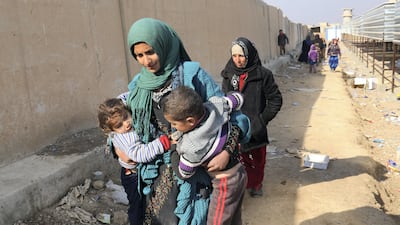Inside the Debaga displacement camp soon after the start of the campaign to liberate Mosul, dishevelled families who had found refuge told a familiar story of hardship.
But those living at the camp in northern Iraq were not from the one million civilians caught up in the battle for Mosul raging to the west.
Instead, many of the families come from the east, fleeing the town of Hawija on a gruelling desert journey through ISIL lines.
Hawija, had fallen to ISIL after the disastrous collapse of the Iraqi military in 2014 and formed part of a broad corridor of ISIL gains jutting east towards the Iranian border.
By the time the battle for Mosul began in earnest last October, the Iraqis had clawed back enough of the country to isolate Hawija into a dusty pocket sitting awkwardly between Iraqi and Kurdish Peshmerga forces.
__________________
Read more:
After liberation of Tal Afar, Iraq sets sights on Hawija district
Kirkuk may be ticking time bomb as it joins Kurdish referendum
Kurd rebels in Iraq mountains shrug off Turkey-Iran threats
__________________
While a brutal urban conflict raged in Mosul, the Hawija pocket festered along with its 100,000 inhabitants.
Its ISIL occupiers were too weak to pose a serious attacking threat, while the Iraqi military was too busy finishing off the terror group in Mosul and allied Shiite militia groups were encroaching on the nearby town of Tel Afar. Cut off from the outside world, the humanitarian situation in Hawija was dire, testified by the steady trickle of civilians filtering through the frontlines.
In July, ISIL resistance in Mosul was finally smashed. Counterterrorism troops, the army and the Shiite militias followed this up with a swift operation to retake Tel Afar in August. Buoyed by these victories, Iraqi commanders are now setting their sights on the final ISIL pockets in the country, including Hawija.
On August 31, Iraqi aircraft dropped millions of leaflets over Hawija, warning residents that an operation to reclaim the town was imminent. After being part of ISIL's self-proclaimed caliphate for more than three years, Hawija is to return to the Iraqi fold.
There is little certainty over how difficult the fighting will be. The Iraqi high command severely underestimated ISIL's resilience in Mosul, while drastically overestimating the number of extremists left in Tel Afar. The terror group has never held out long against a concerted assault on small Iraqi towns like Tel Afar, which is similar in size to Hawija.
Both of these small, backwater towns have long been hotbeds of Sunni militancy.
During the bloody insurgency waged after the US invasion, Tel Afar and Hawija quickly became Al Qaeda strongholds. In Hawija, resistance to US occupation and the new Shiite-dominated government was so intense that American troops dubbed the town the "Anbar of the North”.
Most residents of Hawija are also Sunni Arabs, and Iraqi forces are about to return to a place where they provided a huge boost to ISIL, Al Qaeda's successor in Iraq.
In 2013, the then prime minister Nouri Al Maliki ordered security forces to open fire on peaceful Sunni protesters in Hawija, leading to a bloodbath. The incident convinced many Sunnis that Mr Al Maliki's sectarian policies could only be countered with violence, and ISIL could count on substantial support from the local population when it stormed across the Syrian border into Iraq a year later.
ISIL's brutal, fundamentalist rule has dampened enthusiasm for the group, and Iraq's military has done much to repair its own reputation.
Shiite militia groups, also known as the Hashed Al Shaabi, announced they will take part in the operation.
The militias have a track record of torturing and killing Sunni civilians, and their presence might alarm Hawija’s remaining population, prompt them to support ISIL defenders and risk inflaming sectarian tensions.
But the Shiite militias seem to have since curbed their worst impulses, with no evidence so far of human rights abuses emerging from their latest campaigns.
The Shiite militias could however ignite the simmering dispute over territory between the Kurdish Regional Government (KRG) and Baghdad. Both lay claim to a broad swathe of territory bordering the autonomous Kurdish region, and to the city of Kirkuk, an city with large oil reserves 45 kilometres to the east of Hawija.
The Shiite militias have been open about their opposition to Kurdish land grabs since 2014. Kirkuk, which the Kurds took over after the Iraqi military fled the onrushing ISIL militants, is the biggest bone of contention. The Yazidi heartland of Sinjar near the Syrian border is another.
Peshmerga and local Shiite Turkmen Hashed units have repeatedly clashed in Tuz Khurmatu, a town near Kirkuk and in the disputed territories. The clashes in Tuz Khurmatu were contained at the time, but many Iraqis fear that with their common enemy gone, the Peshmerga and the Hashed could eventually turn on each other, tumbling Iraq into renewed conflict.
The Peshmerga are poised to take part in the Hawija operation, bringing the Kurds and the Shiite militias into touching distance in yet another part of Iraq that both helped liberate from ISIL.
Knowing that defending Hawija is a lost cause, ISIL militants might choose to abandon the town and melt away into the nearby Hamrin Mountains to the south. The inhospitable mountain range lends itself to a hit-and-run insurgency that would be difficult to eradicate.
Unable to cross the desert border into Syria like many of Tel Afar's defenders are thought to have done, the only lifeline for the jihadists of Hawija might be running to the hills to prolong the ISIL presence in the area. Kurdish commanders have told local press they are convinced that ISIL fighters have already started relocating to the Hamrin Mountains.
Having failed to hold down the vast tracts of territory it once controlled in Syria and Iraq, the terror group has little choice but to seep into the hinterland, where it can hope to regain strength and wait to exploit furture crisis in Iraq.

